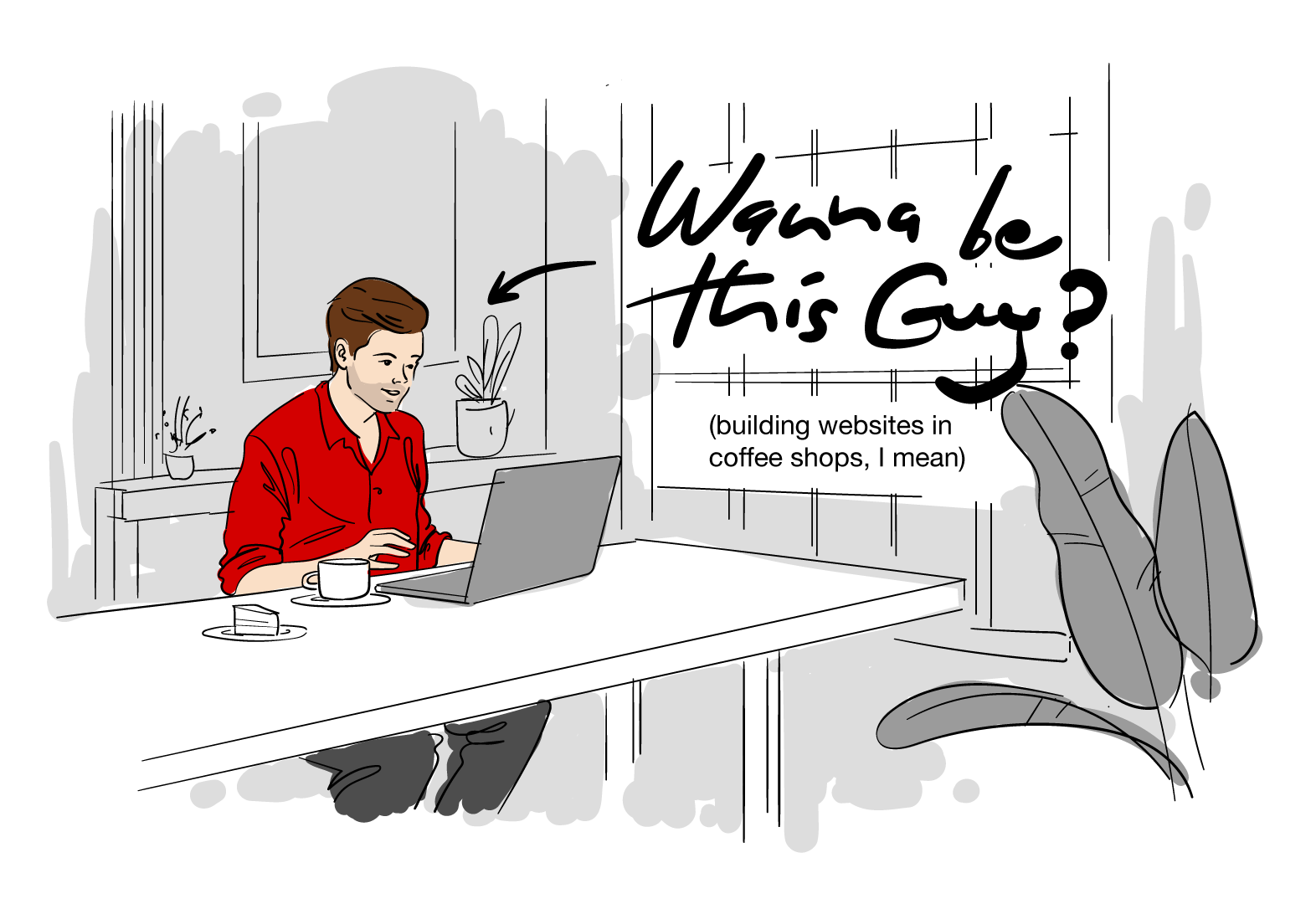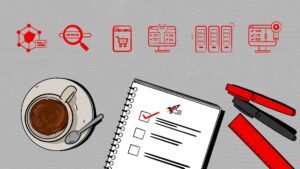Building my own web design business is the most fun I’ve ever had while working. It was also a ton of work.
There is nothing easy about building a business, and the same goes for building your own digital marketing agency. It takes skill, commitment, persistence, courage and consistency. There are no shortcuts.
Except, of course, when there are…
I’m going to give you some of those shortcuts. Right here, right now. (I can hear the frustration in my dad’s voice already. “Giving away trade secrets??” he’s probably saying.)

And there’s no need to invest your hard-earned cash in an expensive or confusing web design course.
Through hard work, patience and a ton of trial and error, I carved my own path to web designer success. Of course, I had a lot of help along the way through various support channels, including random internet people who helpfully wrote advice for me to find through Google. (Which I used to build my own SEO strategy and then turn around and offer premium SEO services to my clients.)
And now it’s my turn to return the favor.
Below, I’ve given you a 13-step plan to follow to build your very own web design business in just 24 hours. Yep, you heard right. 24 hours.
It can take longer, of course. But that all depends on you. (and the current level of your web designing skills)
How to Start a Web Design Business in 13 Steps

OK, no more idle chit-chat. Let’s get to work.
1) Ask yourself “Why?”
No, seriously. Ask yourself why you want to do this.
As I just finished saying, starting a web design business is a lot of work. Don’t get me wrong, the fruits of your labor will be so worth it. But you need to have your goals and objectives clearly defined.
When you get stuck in a line of code, or have to deal with a demanding customer who has no idea what they want, or need to turn down yet another social invitation to meet a deadline, you’ll need to revisit why exactly you’re doing this in the first place. It will keep you motivated and consistent.
“Everyone has a plan until they get punched in the face.” – Mike Tyson
For me, I wanted to build a location-independent online business that allowed me to spend more time doing things I love.
To do that, I needed to keep my life simple and make a modest income. After extensive research, it became clear that running my own web design business would allow me to do just that.
2) Find your niche
You’re probably sick of hearing this cliche beaten to death. But do you want to know why it’s repeated so often?
Because it’s 100% true.
This is especially the case in the web design industry. Web design is so incredibly crowded. The competition is fierce.
Worse yet, many people have had negative experiences with web designers. For some, just hearing “website design” said out loud is enough to coat their brain in molasses.
How many times have you received a broken-English phone call or email from India trying to sell you web design? For some, this is the first thing that comes to mind when someone starts talking web design with them.
Between intense competition and negative associations with your work, you’re going to have your work cut out for you. It’s not enough to simply be a “web designer”.
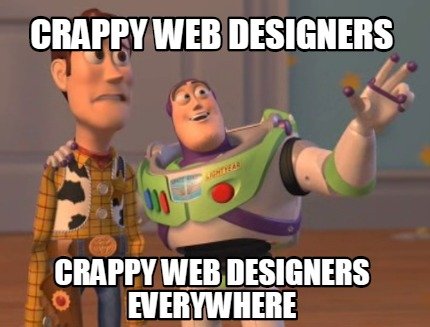
What makes you different? Why are you special? What do you have to offer that no one else does?
Answering those questions will help you carve out your own small piece of the massive web design pie.
While searching for my own web design niche, I discovered that while everyone was offering websites that were “beautiful“, “professional“, “responsive” and “affordable“, essentially no one was selling fast web design.
That was my ticket.
I built my entire business around that simple premise. While most designers take weeks or even months, I can build your website in just a couple of days. In one case, I even built a website for a gentleman in less than 24 hours.
RELATED: How I Landed One of the Biggest Executives in Canada as a Client
3) Establish your brand
You know what I called this web design business that specialized in fast website design?
RapidWebLaunch.
Catchy? No. Sexy? Not at all. Easy to remember? Not really.
But if you had to ask someone what I do based on the business name alone, I’m pretty confident that they’d be able to answer correctly.
A successful brand does just that. It effectively communicates your value proposition as simply as possible. Your brand is made up of things like:
- Logo
- Color guide
- Slogan/tagline
- Voice/messaging
Logo
If you have the cash, have a professional graphic designer make for you. But if you’ve got nothing in the piggy bank, like I did, you can make your own logo.
Make sure that your logo will look great no matter where it’s placed. (like social media channels, for example)
Color guide
Pick 2 or 3 colors that will be the core of your entire brand. These will be used in everything from your logo, to your website, to your marketing materials, and everything in between.
Slogan/tagline
Make it simple but catchy.
Mine? ? Fast and affordable web design. Guaranteed.
Voice/messaging
Maybe you found this one a bit confusing.
You need to think of your brand as a person. What are this person’s values? Likes and dislikes? Strengths and weaknesses? Style of speech? Age? Gender?
It’s important to consider your target audience when developing your brand’s messaging. If you’re going after the 60+ seniors crowd, then they’re not going to want to listen to some beanie-wearing, frappucino-sipping, Snapchatting punk like you.
4) Register your domain name
Now that you’ve come up with a company name, brand and logo, it’s time to register your domain!
(note: some people like to check and see if their preferred domain name is available before settling on a company name, so you can reverse the order of steps #3 and #4 if you’re one of those people)
There are myriads of companies that you can use to register a domain with.
That said, depending on the web design tool you decide to use, you may not even need them…
5) Pick the right website design tool

Now things are getting interesting.
There are so many different website builder tools these days. I’m sure you’ve heard of a bunch of them. Here are some of the most popular options to choose from.
Let’s take a quick look at each one, shall we?
Weebly
Weebly is one of my favorites. It is by far the easiest to use, and makes it super simple to allow your customers to edit their own site whenever they need to. A big feature that pretty much everyone wants.
Also, from a business perspective, Weebly has a separate version of their platform made just for web designers like you and I.
This makes it really easy to white-label their products and present yourself professionally.
Some snobby web designers write Weebly off as being “too simple”, but that all depends on your perspective. My target audience is small business owners who want to get online fast and affordably. They have little to no online marketing knowledge.
This made Weebly the perfect fit for me and my business.
At least, for a time.
Now that my business has grown and my skills have improved, I’ve moved on to WordPress.
RELATED:
- How to Get Your Weebly Website on the First Page of Google With Killer SEO
- 8 Beautiful Websites You Won’t Believe Were Made With Weebly
Wordpress
Wordpress is the most popular web design platform in the world, and for good reason.
It’s extremely versatile and customizable. You can make Wordpress become anything you need it to be. This very blog runs on Wordpress.
But, with that awesome versatility comes increased complexity. There is a rather steep learning curve. If you are a complete web design noob, you will find it challenging.
If you’re going to become a web designer, you should learn Wordpress at some point. Until then, use a simpler tool like Weebly to get some experience under your belt.
I use WordPress for nearly all of my clients’ websites at this point.
RELATED: Weebly vs Wordpress: Which Web Design Platform is Right For You?
Shopify
If you’re specifically focusing on building ecommerce websites for your customers, then you need to be building with Shopify. Straight up.
It is the #1 ecommerce web design platform in the world. They’re constantly pioneering new products and ideas to make selling goods online dead simple.
They also have a reseller version of their platform, where you can build multiple sources of income with their various products.
Squarespace
I have been advertised to by Squarespace on Facebook, Twitter, YouTube, Instagram, TV, radio, billboards and pretty much all of my favorite podcasts. They’re everywhere.
There’s no doubt that they’re popular, but I can’t say I have an opinion on them. Simply because I’ve never used their product.
I recommend you check them out for yourself and see what you think.
Wix
Wix is another popular DIY web design platform. Simpler than Wordpress, but more advanced than Weebly, it boasts a number of features that I’ve yearned for in Weebly’s platform.
But, from my experience, Wix’s website loading speeds are very poor. Something to keep in mind. Give it a try for yourself and let me know if I’m wrong!
Jimdo
I know nothing about Jimdo. Honestly.
I know they’re a small player in the DIY web design world. That’s about it. Didn’t feel right to not include them in some way.
6) Time to build your website!
Woop woop! Let’s get building!
You now have everything you need to get started on your own website.
I could write a gazillion separate blog posts on what it takes to build a successful website, but ain’t nobody got time for that. For now, just remember these core principles:
- Keep it simple. Less is more. Clean, minimal, beautiful.
- Your website is nothing with out high quality images and video. They should make up about 70-80% of your content.
- Always design with the phone in mind. The majority of traffic now comes from mobile. Ensure your site is 100% responsive for all devices!
- Speed is everything. Make sure you’ve compressed all of your images to ensure they are as small as possible without sacrificing quality. And don’t add too much fancy coding or bloated apps and extensions!
- Your user experience needs to be fantastic. Make it crystal clear what you expect your visitors to do. Guide them down that path. Want them to subscribe to your newsletter? Buy a hand-made cup warmer? Call you? Show them how. If you don’t, your visitors will leave as fast as they arrived.
- Don’t make any of these super common web design mistakes. ????
There’s obviously a bit more involved to building a great website, but this is enough to get you started. You’ll learn as you go, just like I did!
7) Choose your invoicing platform
You do like getting paid, don’t you?

You want an invoicing platform that:
- Makes it super easy to design beautiful and professional invoices
- Automatically tracks expenses (you’ll thank me at tax season)
- Has automated recurring invoicing for subscription-based products
- Can process credit card payments
They have a free version as well. Perfect for when you’re just starting out.
RELATED: My FULL Review of FreshBooks
8) Setup your credit card processor
Like I said, I use Stripe.
Don’t start building sites for clients until you have this setup. Almost everyone wants to pay with credit cards these days. It protects both you and your customer.
You’ll also have the ability to preauthorize charges from customers. I don’t start any job until I receive a 50% deposit.
50% before the job starts, 50% once the job is done. Weeds out all the sketchy folks.
9) Promote your shiny new web design business!
You’ve got your logo, brand guide, website, and invoicing and payment processing setup. Now you’re ready to start building websites and making paper!
Setup a profile here:
- Google My Business (crucial)
- Yelp (just as a placeholder, really)
- Facebook (if you think you need to… I personally hate Facebook and have now deleted it)
- Twitter (used to be my fav social network, but it’s far too toxic these days)
- Pinterest (great for blog traffic)
- YouTube (if you’re not videoing, you’re way behind)
- Instagram (I don’t use it for business marketing, but more as proof that I practice what I preach)
- Reddit (can be very useful if you have thick skin)
- Quora (mostly for thought leadership)
- Launchers (the social network for web designers!)
We’ll leave it at that for now. Remember to only pick a handful of these platforms to invest your time into. If you try to use all of them, you’ll spread yourself thin and accomplish nothing. Stay focused!
RELATED: How to Get More Google Reviews From Your Customers (in One Simple Step)
10) Finding new clients
This is the hardest part about being a web designer by far.
There are a lot of different places online where you can find people looking for web designers, but let me tell you this:
Your most valuable asset is YOUR network
Your friends, family, coworkers, social media contacts, current or former customers, anyone you have a decent relationship with. These are the people that will help you get clients when you don’t have a portfolio.
It will take time. You’ll need to be patient and work hard. But you will start to see a “snowball effect” as you finish one website after the other. One delighted customer spreads the word to everyone in their network and so on and so on…
Now that I’ve got that out of the way, here are some other places that could be good for freelancers like yourself.
Upwork
Upwork is the most popular freelancing platform in the world. It has it’s fair share of both ambassadors and detractors.
You can find some decent-paying jobs on here. Just be prepared to put in a lot of work to stand out from the massive crowds of intense Indian and Filipino competition. Especially when you don’t have experience to lean on.
Guru
Guru is like Upwork, just smaller. ‘Nuf said.
Google Maps
Want new web design clients fast? Go local.
Pull up Google Maps, find all the local businesses in your area and see if they have a website. If they don’t, go pay them a visit. If they do, but it sucks, go pay them a visit.
I can hear you complaining already. “I have to talk to people in person?” “But I suck at sales!” “I’m too shy to do that.”
The best stuff happens in that little area just outside of your comfort zone. You can do it. ????
Craigslist
It’s old school, but it can still work.
Most people who know nothing about web design, but know they need a website, have no idea where they should turn to to find a web designer. So, they head to the same place they look for anything else they need to buy, Craigslist.
Get on there and start replying to people’s requests. Just be ready to not get paid much.
RELATED: How NOT to Sell Web Design Services (10 Mistakes to Avoid)
11) Obsess over your customer experience
When you finally land that first web design client, you need to treat them like a freakin’ princess. I’m talking mind-blown levels of good.
Your customers will always be your most powerful asset. From the moment they first find you online to the second they send you final payment, they need to be “wowed”.
Nothing is too small. Every little interaction should be furthering your brand’s message.
For example, here is what my visitors see after they submit a request for a quote:
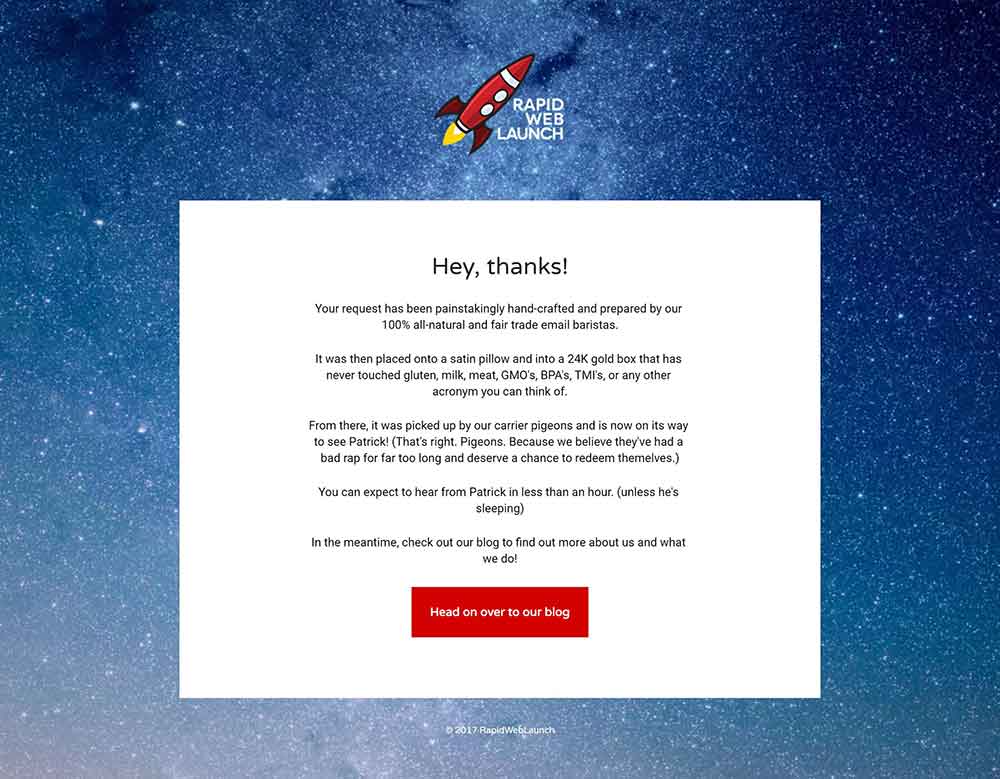
It’s small, but it’s more memorable than “Thanks for submitting! We’ll get back to you soon.”
And here is what happens when my blog visitors get a 404 page on my blog:
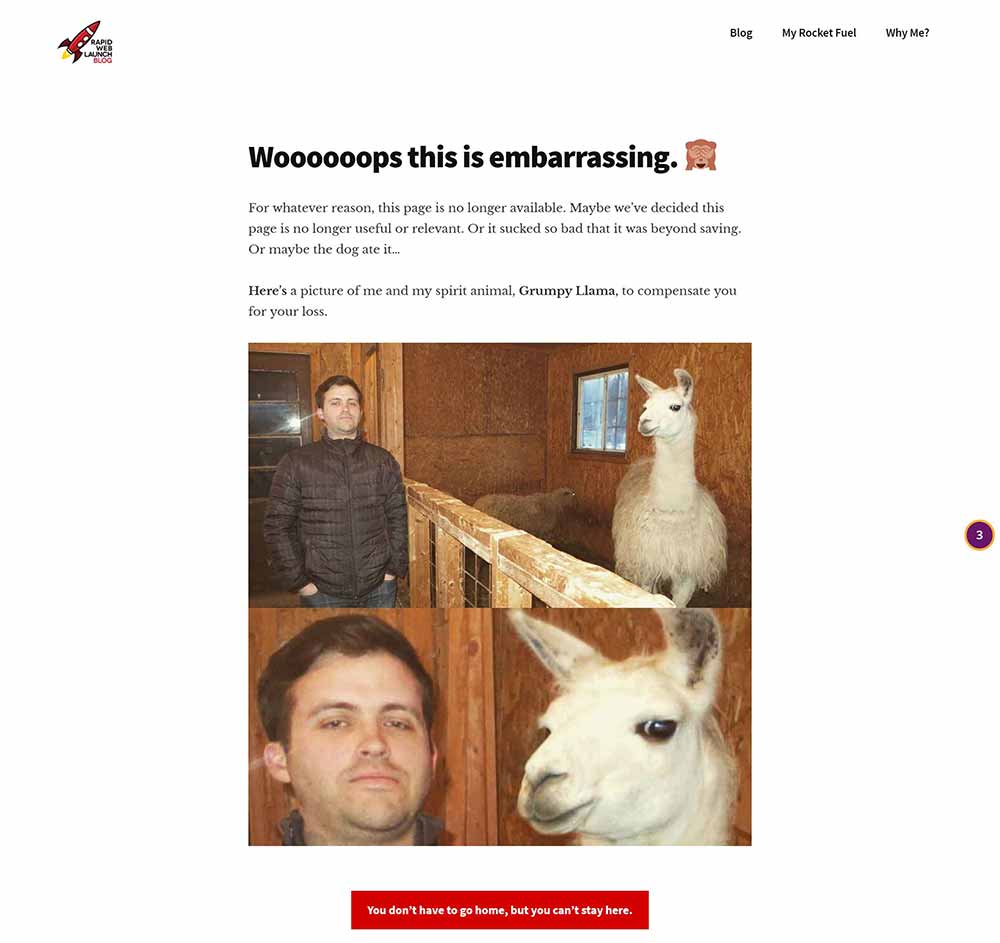
If you can perfect your customer experience, you will have no trouble building a successful web design business.
12) Implement scaling and automation
Automate as many tasks and procedures as you can. Things like:
- Sending invoices
- Payment processing
- Email communications
- Lead generation
- Funnel management
There’s a lot to unpack here, and I’ll have to write about it in separate blog posts. I’ll post them here as I do.
For now, just focus on getting off the ground and gaining new customers.
13) Think of additional services you can offer
Small businesses need websites. But what else do small businesses need?
Things like:
- Logo Design
- Branding
- Search Engine Optimization Services
- Content Marketing
- Blogging
- Video Production and Editing
- Website Management Services
Get creative. How many problems can you solve for your customers?
I started out offering nothing but web design services. As I sharpened my skills, I branched out into additional products and services. Like the ones listed above.
At the risk of sounding redundant, be careful not to spread yourself too thin in the beginning. Start with building your web design skills, then slowly grow from there.
I’m now at the point where I have a small team helping me to keep up with demand. Growth FTW!
RELATED: How to Create REAL Passive Income With Your Web Design Business
Ready to start your own web design business?
No matter what, this will take a lot of work. But nothing in life that is worth having comes easy.
“You don’t have to be great at something to start, but you have to start to be great at something.” – Zig Ziglar
While you can certainly follow this guide to have your web design business built and ready to go in just 24 hours, you can also take your time with it and grow at your own pace.
And there will certainly be many ups and downs. Customers tend to come in waves. One minute you’ll have more customers than you can handle, and the next you’ll be begging for new customers.
But that doesn’t mean there is no work to be done. Business downtime is the perfect time to get involved in other activities.
No matter what, just start.
RELATED: Allow Me to Dismantle Your 14 Biggest Excuses For Not Starting a Business
I feel like I’ve provided a pretty clear path towards building a web design business from scratch. I hope you find it helpful!
If you need some help, shoot me an email at [email protected].
FAQ’s

Here are the most common questions I get about starting a web design business:
How much should I charge for website design?
I get this question so often that I wrote an entire blog post about it right here. There is no simple answer to this question. The popular answer is to simply “charge what you’re worth” but, when you’re first starting out, it’s not that simple.
Personally, I always quote on an individual basis. I decided early on how much I want to make per hour, and then I estimate how many hours it will take to build the website. That being said, I offered heavy discounts in the beginning in order to build up my portfolio. It’s difficult to convince someone to work with you when you have zero proof of your skills.
Be prepared to work for free a few times!
How do I hand the website over to a client when it’s done?
It depends on the client and their skill level. Some will be comfortable enough that you can just hand the site over, while others need more hand-holding.
The rest depends on the tool you’re using. Most popular CMS tools offer the ability to create logins for separate accounts, so you can just create a new account and send your client the login.
If they prefer complete privacy and security, you can delete your own account after creating one for them.
When should I increase my prices for website design?
Raising your prices is a very gradual process. There’s not specific number.
What I can tell you is that when I got to the point when I no longer NEEDED a client in order to pay the bills that month, that gives you the total freedom to charge what you want and pick the clients that are right for you. But that will take time.
Try not to beg for business! People won’t respect you otherwise.
How do I provide an accurate quote for website design?
Decide what your minimum hourly rate is, then quote based on hours. So, if you decide you need to make a minimum of $30/hour, and the website will take about 10 hours to make, you can quote for $300.
There are many ways to quote, but that’s how I do it.
What type of skills do I need to know in order to become a web designer?
I get this question so often that I wrote an entire blog post about it. Read it here: Want to Become a Web Designer? Then You Need to Have These 10 Skills
Should I register my client’s domain name myself, or have them do it and give me access to it?
Depends on the client. Most of my clients already have a domain so they just provide me access to it.

